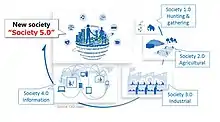
| History of technology |
|---|
Society 5.0, also known as the Super Smart Society,[1] is a concept for a future society created through a new industrial revolution, introduced by the Japanese government in 2016. The plan proposes integrating various technologies, such as artificial intelligence, more effectively into society.[2][3]
It emerged as a concrete manifestation and adoption of the Fourth Industrial Revolution and was first introduced by the Japanese government's Cabinet Office's Council for Science, Technology, and Innovation.[3] The unveiling of Society 5.0 took place within the framework of the 5th Science and Technology Basic Plan, presented by the late Japanese Prime Minister Shinzo Abe in 2019. This approach envisions a human-centric society that harmonizes economic progress [4] with the resolution of societal challenges. It suggests this equilibrium can be achieved by integrating the realms of cyberspace and physical space. [5] [6]
Objective
The objective of Society 5.0 is to enable each person, encompassing our society and individuals, to experience a safe, secure, comfortable, and healthy life while also having the opportunity to manifest their desired lifestyle. The social transformation within Society 5.0 aims to establish a progressive society that overcomes the current feeling of stagnation. It envisions a society where individuals hold mutual respect, transcend generational boundaries, and where everyone can lead an active and enjoyable life.[5]
History
The term Society 5.0 comes from the intention of creating a fifth new society by making the best use of digital transformation, after going through several societies such as the hunting society (Society 1.0), the agrarian society (Society 2.0), the industrial society (Society 3.0), and the information society (Society 4.0).[7]
Society 1.0 (Hunting Society)
A hunter-gatherer society is an anthropological concept that characterizes a society's way of life as being dependent on hunting and collecting wild animals and plants for sustenance. It is believed that all human societies followed a hunter-gatherer lifestyle until the advent of agriculture during the Neolithic era/period.[8]
Society 2.0 (Agricultural Society)
An agrarian society is a societal structure in which the economy primarily relies on agriculture. The origins of agrarian societies are associated with the Neolithic Revolution, also known as the First Agricultural Revolution, which took place during the Neolithic or Stone Age. These societies have persisted in various parts of the world for thousands of years since then, up to the present day, making them the most prevalent form of social and economic organization throughout history of human organizational work in preindustrial times. [9]
Society 3.0 (Industrial Society)
An industrial society is one that has made significant progress in industrialization, and it is also referred to as an industrialized society. In many instances, industrial societies follow a previous stage characterized by an agricultural society, including making full use of technologies across different fields for a human-centered society [10]
Society 4.0 (Information Society)
An information society is a society in which activities related to the utilization, generation, dissemination, and incorporation of information hold considerable importance. The primary catalysts behind this phenomenon are information and communication technologies, which have led to the rapid development of automatic machines and robot for revolution of industry and information. [11]
Technology Applications
Japan's National Institute of Advanced Industrial Science and Technology report lists the following six topics as basic technologies for realizing Society 5.0:
- Technology for enhancing human capabilities, fostering sensitivity, and enabling control within Cyber-Physical Systems (CPS).
- AI hardware technology and AI application systems.
- Self-developing security technology for AI applications.
- Highly efficient network technology along with advanced information input and output devices.
- Next-generation manufacturing system technology designed to facilitate mass customization.
- New measurement technology tailored for digital manufacturing processes.
The Japan Business Federation (Keidanren) initiated "Society 5.0 for SDGs" in alignment with the United Nations' Sustainable Development Goals (SDGs) due to the compatibility between Society 5.0 and the SDGs.[12]
See also
References
- ↑ ""Super Smart Society (Society 5.0)" mission area". Japanese Government, Science and Tech Bureau website. Retrieved 2023-10-12.
- ↑ M. Hanefi Calp; Resul Bütüner (2022). "Chapter 7 - Society 5.0: Effective technology for a smart society". Intelligent Data-Centric Systems. Academic Press. pp. 175–194. doi:10.1016/B978-0-323-88468-6.00006-1. ISBN 9780323884686. Retrieved 30 November 2023.
- 1 2 "Society 5.0 or ソサエティー5.0". Japanese Government, 2016. Retrieved October 10, 2023.
- ↑ "Impact of "Society 5.0" What is the fifth new society?0". Toshiba Co. Home Page. Retrieved 2023-10-12.
- 1 2 "Society 5.0". Cabinet Office Home Page. Retrieved 2023-10-10.
- ↑ "Modeling and AI that Connects the Cyber and Physical Worlds". Japan Science and Technology Agency. Retrieved 12 October 2023.
- ↑ "政府広報オンラインによるSociety 5.0の説明". Archived from the original on 2018-01-03. Retrieved 2022-03-19.
- ↑ "Realizing Society 5.0" (PDF). Japan Gov. Retrieved 2023-10-13.
- ↑ "History of the organization of work (during agriculture era)". Britanica. Retrieved 12 October 2023.
- ↑ "Making full use of AI and technologies across different fields for a human-centered society". Japan Science and Technology Agency. Retrieved 12 October 2023.
- ↑ "Development of Smart Robot for Revolution of Industry/Information". Japan Science and Technology Agency. Retrieved 12 October 2023.
- ↑ "Society 5.0 for SDGs | 経団連". keidanrensdgs (in Japanese). Retrieved 2023-10-10.
